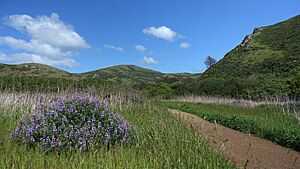Tennessee Valley, California facts for kids
The Tennessee Valley is a beautiful, natural area in Marin County, California. It's located close to the town of Mill Valley. This valley was once home to ranches. There were even plans to build a new city here!
But instead, in 1972, the valley became part of the Golden Gate National Recreation Area. More land was added to the park in 1974. Today, it's a great place for outdoor fun. You can find horse stables, a special plant nursery, and many trails. People enjoy hiking, biking, and horse riding here. A 1.7-mile trail is easy for everyone to use. It leads right to Tennessee Cove and its sandy beach.
Contents
History of Tennessee Valley
Early Inhabitants and Wildlife
Long ago, the Coast Miwok tribes lived in the Tennessee Valley. They lived all over Marin County. The first European settlers called this area Elk Valley. This was because many wild animals lived here, including Tule elk. Sadly, the Tule elk are no longer found in this area.
How Tennessee Valley Got Its Name
The valley's name changed because of a famous shipwreck in 1853. A passenger steamship called the S.S. Tennessee was sailing in thick San Francisco fog. The ship missed the Golden Gate entrance to San Francisco Bay. Instead, it accidentally turned into Indian Cove, which is now called Tennessee Cove. This cove is about 4 miles north of the Golden Gate.
The ship's captain was very skilled. He managed to guide the ship safely onto the beach. This saved all 500 passengers and 14 chests of gold! If you visit the beach at a very low tide, you might still see the engine of the S.S. Tennessee.
The Marincello City Plan
In the 1960s, there was a big plan to build a new city called Marincello. This city would have covered much of the Marin Headlands, including most of Tennessee Valley. Marincello was designed for 30,000 people. It would have had apartment buildings, houses, and light factories.
However, the plan was stopped. Many people did not want a new city built in this natural area. There were also money problems. Only one small neighborhood of about 240 homes was built before the project ended. You can still see some signs of the failed city. For example, the Marincello gate and trail follow what would have been the city's main road.
Nature and Wildlife
Tennessee Valley is home to different types of natural areas. You can find coastal scrub and open grasslands. There are also areas along Tennessee Creek where plants grow near the water. This is called riparian habitat.
Tennessee Cove and Its Waters
Tennessee Cove has a small lagoon and a beach. The ocean waters just offshore are protected. They are part of the Monterey Bay National Marine Sanctuary. This helps keep the marine life safe.
Plants of the Valley
Many types of grasses grow here. Some are native, like purple needlegrass, California oatgrass, and red fescue. But there are also invasive grasses. These include rattlesnake grass, wild oats, and brome grasses. Many of these non-native grasses were planted long ago. Ranchers wanted grasses that their livestock could walk on and eat.
On the hills and ridges, you can find other common plants. These include coyote brush, poison oak, California sagebrush, sticky monkeyflower, and California blackberry. Some non-native trees were also planted and still grow well here. These include Monterey cypress, Monterey pine, and blue gum eucalyptus.
Helping Local Plants Grow
The Tennessee Valley Native Plant Nursery is a special place. It's part of the Golden Gate National Parks Conservancy. Volunteers at the nursery collect seeds from local plants. They grow these seeds into new plants. Then, these new plants are used to help restore natural habitats all across the Marin Headlands.




